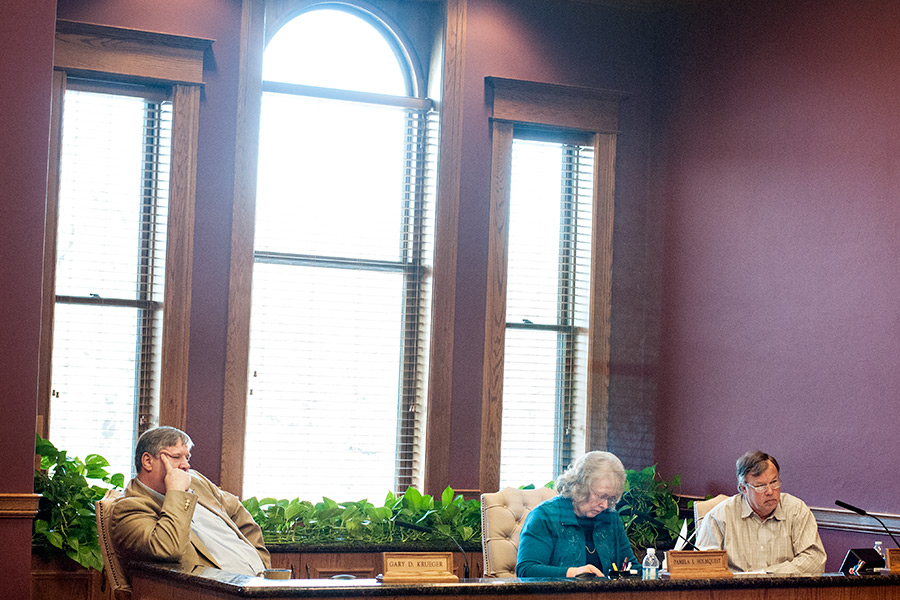The Flathead County Commission made money-saving decisions on the county’s $7 million South Campus building project, cutting out thousands of dollars worth of items that the architects and contractor deemed unnecessary or changeable.
Project leaders came up with the list at the request of Commissioner Phil Mitchell, who said he wanted to save as much money on the building as possible since it came in at about $1 million more than expected.
At the Jan. 28 hearing, the commission went through the itemized list, giving a yes or no on which items they would like to delete from the project.
The commission was largely in agreement about the list, except for one item: an outdoor patio on the west side of the building that would serve the senior population using the gathering area for the county’s Agency on Aging program.
Removing the patio from the project would save $10,000 on the project, and Mitchell said he believed it was an unnecessary addition to the building, which will house AOA, the Kalispell Senior Center, part of the county’s IT department, and space for the Flathead City-County Health Department.
Commissioner Gary Krueger said he believed the patio is an important component for the public, and that the county pays to operate outdoor eating areas for the jail and juvenile detention facility. The seniors shouldn’t be “warehoused” indoors, he said.
Mitchell, however, said that while people may be upset with the decision not to include the patio, he believes the county has given the seniors everything else they have requested, including keeping the wood floors for the exercise area.
Removing the patio and the west-side building overhang that would shade part of it would save taxpayer dollars, Mitchell said, and he didn’t believe it would be used much.
“The amount of time senior citizens spend outside on a patio is very minimal,” Mitchell said.
The patio falls under the “want” category when considering wants versus needs, he added, and the county has other large projects, such as saving for a new detention center and maintaining roads, to consider when spending taxpayer money.
Mitchell said that based on earlier public testimony during which someone mentioned the possibility of a fundraiser, that the senior community could raise the money to put in the patio.
A fundraiser would be a nice way for the seniors to show appreciation for everything the county is doing when building this new facility, he said, and that the building is a “huge step up from where you are now.”
“I’d like to see the senior citizens do a small fundraiser,” he said.
Krueger disagreed, saying that if the county is building a $7 million facility and needs a fundraiser from citizens for a $10,000 expenditure, “we are in trouble.”
“Our senior citizens have been taxpayers for long enough,” Krueger said.
Commissioner Pam Holmquist said she “struggles” with the patio item, and that even without it, the new South Campus building will be a beautiful, functional area for the seniors.
With two commissioners in favor of dropping the patio, it was removed from the project.
Other items the commission chose to change included using different material for the trash enclosure to save $15,000; changing the building’s exterior seating wall to save $17,000; saving $2,900 by using different fencing material; saving $10,000 on landscaping expenses; saving $70,000 on some foundational work; and eliminating $40,000 for the planned skybridge because the health department has offered to pay for it.
The county will save $20,000 by not using mitered corners and aluminum extrusions on the building’s exterior; $15,000 by removing a planned skylight; $15,000 by changing the interior tile quality and not using as much epoxy grout; $4,000 by removing certain wall coverings; and $10,000 by using different window coverings.
An initial cost-saving item of changing elevators was removed from the list, with the original plan staying in place.
The commission decided to eliminate a $5,000 battery backup for the elevator, choosing instead to loop it in with the backup generator for the building. The county will save $5,900 by changing up the hoods on the kitchen equipment, and could possibly save more than $10,000 on electrical items.
Some other items, such as a $12,000 third-party electrical system test, were left on the list so the commission could gather more information before making a decision.
Given the commission’s preferences on the items, the architects and contractor will work on adjusting the overall plan and bring back the final amount of savings, a representative of CTA Architects Engineers said.
